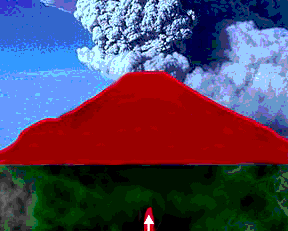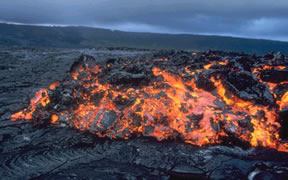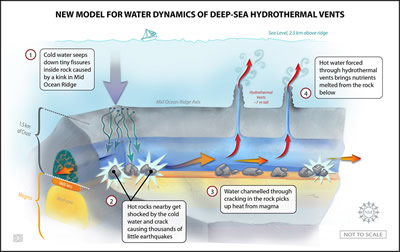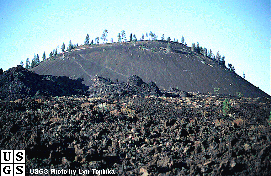This is a drawing of seafloor spreading.
Click on image for full size
Image copyright 1997 by the American Geophysical Union. Further electronic distribution is not allowed.
Mid-Ocean Spreading Ridge
As the Earth cools, hot material from the deep interior rises to the surface. Hot material is red in this drawing, under an ocean shown in blue green.
The hotter material raises the nearby layers, and the cooler, harder crust (in yellow in this drawing) slides away from the higher regions. The drawing shows that the cool crust slides at a rate of about 3 inches per year. The elevated region where new material is coming forth is called a "spreading ridge". Most of the spreading ridges of today are to be found in the central portion of the world's oceans.
The large version of this drawing shows a spreading ridge at the left and a slab of lithosphere being subducted at the bottom right. Near the subducting slab, remelting, and volcano formation are taking place.
You might also be interested in:

When two sections of the Earth's crust collide, one slab of lithosphere can be forced back down into the deeper regions of the Earth, as shown in this picture. The slab that is forced back into the Earth
...more
Volcanoes form when hot material from below risesand leaks into the crust. The hot material, called magma, rising from lower ground, gathers in a reservoir called the magma chamber. Eventually, but not
...more
Basalt is volcanic rock. It is the most common type of rock in the Earth's crust and it makes up most of the ocean floor. It forms when lava reaches the Earth's surface at a volcano or mid ocean ridge.
...more
A group of scientists have been studying an area of the ocean floor called the East Pacific Rise, which is about 565 miles southwest of Acapulco, Mexico. The East Pacific Rise is a ridge along the ocean
...more
Ash is formed as a volcano erupts when rocks made by the volcano blow apart into millions of tiny pieces. The rocks are still very hot, because they just formed from lava. If the hot rocks come into contact
...more
Cinder cones are simple volcanoes which have a cone shape and are not very big. Compare the size of this volcano to the strato-volcano in this image. They are usually made of piles of lava, not ash. During
...more
Lava can move in two ways, wide flat lava flows, or through channels which squeeze the lava into a small area. The fastest lava flows move at about 6 mi/hr, an easy jog, but they average between 2/3 and
...more















